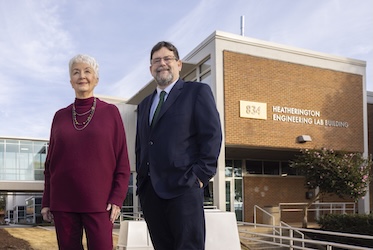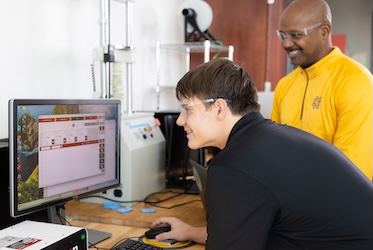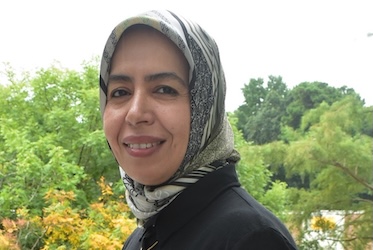

MARIETTA, Ga. | Nov 13, 2018
Professor’s research puts students on the path to discovery
In an unassuming lab tucked away on Kennesaw State University’s Marietta Campus, several electrical engineering alumni have gained the invaluable research experience they say landed them careers at industry leaders such as Lockheed Martin and Harris Corporation.
Though they have varied backgrounds with research spanning many industries, they all have something in common: assistant professor Hoseon Lee.
Since joining the University in August 2013, Lee has sought ways to increase access to research opportunities within the Southern Polytechnic College of Engineering and Engineering Technology, and has modeled his courses in such a way that guides students into a handful of his own projects.
He created a course in electromagnetic and microwave applications, in which he teaches software and hardware skills essential to industry, as well as theoretical knowledge of high frequency and wireless systems. The course pulls heavily on his own experience working as an engineer for companies including Samsung Electronics and BlackBerry, and serves as an important bridge from the classroom into his lab.
“This is just one way I encourage many of my students to transition into research,” said Lee, who typically invites his students to join him for one to two semesters of directed research. “It’s been rewarding for me as an educator because a huge part of the job is preparing our students for careers. The research is right in line with that because it takes what they’ve learned in the classroom to the next level by offering them an experience they wouldn’t otherwise have.”

Today, more than a dozen students who have conducted research in Lee’s lab have gone on to secure full-time jobs or gain admission into competitive graduate programs, and another 19 undergraduates are actively participating on his projects.
Among those who have benefited from Lee’s approach is Kazeem Olorunlambe, a circuit card assembly engineer at Harris Corporation who graduated from Kennesaw State in December 2017. He took three courses with Lee before joining a team of students researching far-field wireless power transfer, a topic that explores how batteries can be charged over great distances using magnetic fields. The team, led by Lee and electrical engineering professor Bill Diong, recently earned a $69,183 Environmental Protection Agency (EPA) grant to reduce aircraft emissions using the technology.
Under Lee, Olorunlambe was given a chance to research methods to reduce carbon emissions in aircrafts through the use of electromagnetic waves. According to the EPA grant proposal, aircraft accounted for more than 11 percent of carbon dioxide emissions from the U.S. transpiration sector in 2013 and remain the largest source of emissions that aren’t subject to greenhouse gas regulations. The International Air Transport Association estimates that each 5.5 pounds in reduced weight equates to one ton reduction in carbon dioxide emissions. The average Boeing 747 aircraft contains as much as 135 miles of copper wire weighing around 4,000 pounds total.
The team has been exploring the feasibility of replacing heavy copper wiring used to power on-board entertainment with wireless power transfer techniques and student-built circuit boards, which could result in significant reductions in airborne pollutants if implemented.
Olorunlambe said the research allowed him to specialize in a specific area: small electronics. His responsibilities included developing circuit boards for testing on prototypes and exploring options for patenting the team’s work. When interviewing at Harris Corporation, Olorunlambe said he relied heavily on the research experience he gained while studying under Lee.
He also gained valuable advice from Lee, whom he grew to admire as a mentor and a friend along the way.
“Being one of the younger professors, Dr. Lee has always very relatable,” said Olorunlambe, who still chats with Lee on a regular basis. “He was candid about mistakes he made as an undergraduate and offered solid advice on what we should do after earning our degree. To me, that makes Dr. Lee a great asset.”

Despite his innate ability to influence students, Lee didn’t originally set out to become a professor, however he did have exposure to academe at an early age. As a child, the South Korean moved to the U.S. while his father studied systems and industrial engineering and later returned to South Korea when his father accepted a tenure-track faculty position.
In 1995, Lee returned stateside to for high school and subsequently enrolled at Georgia Tech, where he earned his bachelor’s and master’s degrees in electrical engineering. Two years into a doctoral program at Georgia Tech, Lee was required to return to home to fulfill his military obligations. Having earned an advanced degree, he was able to secure a teaching role in the Korea Naval Academy, where he taught electrical engineering to midshipmen.
After three years of service, Lee returned to finish his doctoral program at Georgia Tech, during which period he interned at BlackBerry in 2011 as an antenna engineer.
“For companies, you tend to work a niche job where you are expected to do similar things over and over,” he said. “The scope of what you can do is very limited in some cases. One of the benefits of doing research at a university is, I could pursue any research idea I wanted to, and I really enjoy that kind of flexibility. As long as I have a scientifically credible idea that has the potential to be successful, I can pursue that.”
Recently, Lee and a team of students began developing a compact electronic device capable of counting white blood cells from the comfort of one’s home.
To monitor white blood cell levels, many clinics currently use a method called flow cytometry, Lee said. The process works by dyeing cells a fluorescent color and then illuminating them by a laser. As the dyed cells pass through a narrow channel, the scattered light and florescence emitted from the cells are detected, indicating an object is there. While the technique can provide medical providers many levels of insight into their patient’s health, the equipment is bulky and expensive, limiting its portability. For some patients, it equates to a lot of time spent traveling to the hospital and enduring long wait times.
Under his guidance, Lee’s students are developing a prototype that is more cost effective, can operate on two AAA batteries and could fit in one hand. The device uses a coil wrapped around a channel just 100 microns wide, which is large enough for a few magnetized blood cells to pass through at a time, sending data to an attached circuit board. Though the team is still perfecting its overall design, Lee said a patent has been filed and his students will have an opportunity to publish their findings in a peer reviewed journal.
Joseph Lee, a senior electrical and mechanical engineering student who built computer simulated models of the device as part of the team, said his involvement with the project allowed him to land a co-op with auto parts manufacturer Denso. He cites Hoseon Lee as a source of inspiration for putting him on a promising career path.
“If I could sum up Dr. Lee in a few words, I would have to say he’s hardworking and diligent,” he said. “He’s fun to be around and always cracks jokes with us, but we still get work done. His involvement has made an incredible impact on me personally.”
– Travis Highfield
Photos by David Caselli

Lawrence Whitman installed as Dale and Ann Heatherington Endowed Chair of Engineering and Engineering Technology

Kennesaw State team innovates stronger 3D-printed structures through advanced simulations

Kennesaw State researchers use drones, artificial intelligence to improve disaster response

Kennesaw State professor awarded NSF grant to strengthen communication skills in engineering education
A leader in innovative teaching and learning, Kennesaw State University offers undergraduate, graduate, and doctoral degrees to its more than 51,000 students. Kennesaw State is a member of the University System of Georgia with 11 academic colleges. The university's vibrant campus culture, diverse population, strong global ties, and entrepreneurial spirit draw students from throughout the country and the world. Kennesaw State is a Carnegie-designated doctoral research institution (R2), placing it among an elite group of only 8 percent of U.S. colleges and universities with an R1 or R2 status. For more information, visit kennesaw.edu.